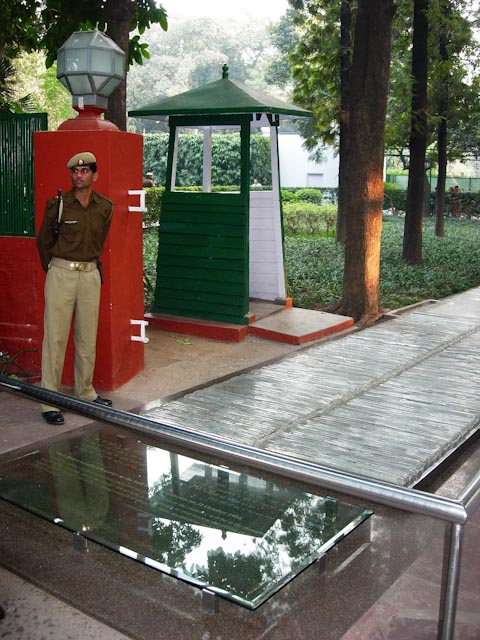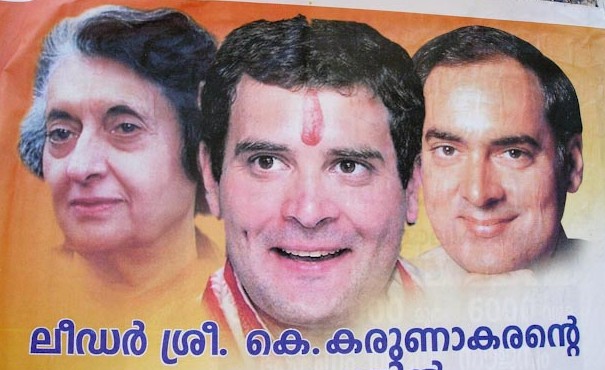Today’s sortie sees me cruising through Connaught Place yet again. Much to my amusement an enterprising lad tries to sell me a big fat Collins English dictionary. I mime lugging the book around and I think he gets that he has the wrong niche market somehow.
Beyond CP I head south to an area full of embassies. Like most cities in the world, they are usually in one of the nicest parts of town and Delhi is no exception to this rule. The streets are broad and lined with trees and relatively quiet.
The Nehru Memorial Museum, also known as Teen Murti House, is an impressive two-storey structure. Set in extensive gardens this broad pale yellow building was the home of Pandit Jawaharlal Nehru. This house became his home when he assumed the leading job in India at Independence until his death 16 years later, when it was decided to convert the place to a museum.
The rooms have been preserved with his original furniture, books and mementoes, with informative signs describe the activities that took place in each room. Other rooms are completely lined with news clippings and photographs detailing his life and the long fight for independence undertaken by himself, the Mahatma and many others. After all the reading I have done it is great to finally put some faces to names. There is also a great deal of background information about Nehru’s father Motilal Nehru, who was also heavily involved in the movement and politically active, explaining to an extent Nehru’s involvement at such a young age, as well as the depth of the intertwined relationship between this family and the nation.
Only a street or so away is Indira’s house. As with her father’s, this place has also been converted to a museum. Interestingly, I almost had Nehru’s house to myself; Indira’s abode however, is crammed with sightseers. I’m not sure if this is an indication of her popularity or the relative recency of her rule. The latter I suspect, as Indira’s authoritarian rule was not always popular and she clearly turned her back on some of the basic principles her father was famous for espousing.
A glass cabinet displays the sari she wore on her final morning and the bullet holes and bloodstains can still be seen. Towards the back of the house the photographs and memorabilia shift to that of her sons Sanjay and Rajiv, the latter also having lived in this house with his young family. Rajiv’s dominate due to Sanjay’s early demise in a plane crash and Rajiv being forced to take on the family mantle. He was the only person Indira felt she could trust.
It was hard not to feel sorry for this handsome avuncular-looking man trying his best to live a quiet normal life. During his days in Cambridge, he and his mates used to hang out at a Greek restaurant. This is where he first laid eyes on the Italian beauty Sonia, and he claims he knew in that moment she was the woman for him. They married and he became a pilot for India’s main airline. On the death of his brother he reluctantly took on the duties of the anointed one at the behest of his mother. I have heard it said that Sanjay’s death might have been a blessing for India in so far as he was considered to be wild and radical. The end for the family was the same however, and Rajiv, in his efforts to get close to the people while campaigning for election, found himself in the embrace of a female suicide bomber. Another glass case displays some highly modern trainers below only fragments of the remains of the clothes Rajiv was wearing when he died.
Leaving the house from the back, you approach the final memorial to Indira. Her final walk amongst the tall trees in her garden that morning has been covered by lengths of crystal-like sticks, with the place she fell covered by a solid sheet of glass. The guards standing sentry at this place are, symbolically, not Sikhs.


Given that I am old enough to remember these events actually taking place, it is a sharp reminder of how fragile democracy can be in a country that is torn in so many different directions. It is a sobering experience to contemplate the misery that this family (with so many similarities to the quasi-royal Kennedys) has experienced in the name of power and civil devotion.
The Italian Sonia still features in many political posters around town and is effectively the face of the India National Congress Party, being its Chair, illustrating India’s willingness to embrace all kinds as its own. She has declined taking on her husband’s duties in full, however. All eyes are now on the next generation, brought to the fore when Rahul performed the traditional duty of circling and lighting his father’s funeral pyre. Judging by some posters I have seen, it would appear that Rahul has already been persuaded to follow in his family’s footsteps. I wonder how hard Sonia tried (if at all) to dissuade him, as surely she has seen enough death (having also cradled the dying Indira). But Rahul is big enough to make his own decisions now and some family destinies call very loudly.

Comments
Total Comments : ( ) You have to register to post a comment.
RECENT COMMENTS